Input interpretation

CuO cupric oxide + NH_4Cl ammonium chloride ⟶ H_2O water + Cu copper + N_2 nitrogen + CuCl_2 copper(II) chloride
Balanced equation
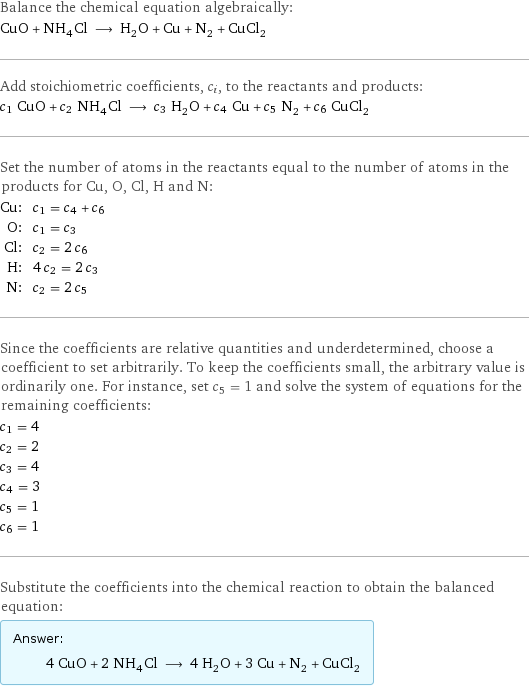
Balance the chemical equation algebraically: CuO + NH_4Cl ⟶ H_2O + Cu + N_2 + CuCl_2 Add stoichiometric coefficients, c_i, to the reactants and products: c_1 CuO + c_2 NH_4Cl ⟶ c_3 H_2O + c_4 Cu + c_5 N_2 + c_6 CuCl_2 Set the number of atoms in the reactants equal to the number of atoms in the products for Cu, O, Cl, H and N: Cu: | c_1 = c_4 + c_6 O: | c_1 = c_3 Cl: | c_2 = 2 c_6 H: | 4 c_2 = 2 c_3 N: | c_2 = 2 c_5 Since the coefficients are relative quantities and underdetermined, choose a coefficient to set arbitrarily. To keep the coefficients small, the arbitrary value is ordinarily one. For instance, set c_5 = 1 and solve the system of equations for the remaining coefficients: c_1 = 4 c_2 = 2 c_3 = 4 c_4 = 3 c_5 = 1 c_6 = 1 Substitute the coefficients into the chemical reaction to obtain the balanced equation: Answer: | | 4 CuO + 2 NH_4Cl ⟶ 4 H_2O + 3 Cu + N_2 + CuCl_2
Structures
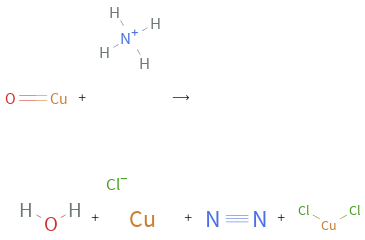
+ ⟶ + + +
Names

cupric oxide + ammonium chloride ⟶ water + copper + nitrogen + copper(II) chloride
Reaction thermodynamics
Enthalpy
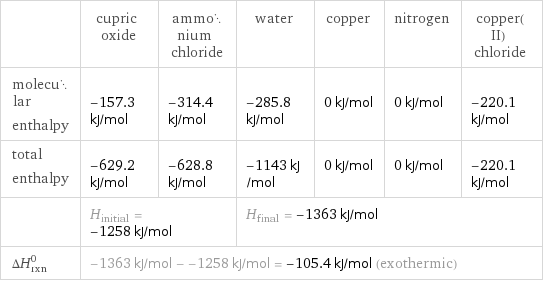
| cupric oxide | ammonium chloride | water | copper | nitrogen | copper(II) chloride molecular enthalpy | -157.3 kJ/mol | -314.4 kJ/mol | -285.8 kJ/mol | 0 kJ/mol | 0 kJ/mol | -220.1 kJ/mol total enthalpy | -629.2 kJ/mol | -628.8 kJ/mol | -1143 kJ/mol | 0 kJ/mol | 0 kJ/mol | -220.1 kJ/mol | H_initial = -1258 kJ/mol | | H_final = -1363 kJ/mol | | | ΔH_rxn^0 | -1363 kJ/mol - -1258 kJ/mol = -105.4 kJ/mol (exothermic) | | | | |
Equilibrium constant
![Construct the equilibrium constant, K, expression for: CuO + NH_4Cl ⟶ H_2O + Cu + N_2 + CuCl_2 Plan: • Balance the chemical equation. • Determine the stoichiometric numbers. • Assemble the activity expression for each chemical species. • Use the activity expressions to build the equilibrium constant expression. Write the balanced chemical equation: 4 CuO + 2 NH_4Cl ⟶ 4 H_2O + 3 Cu + N_2 + CuCl_2 Assign stoichiometric numbers, ν_i, using the stoichiometric coefficients, c_i, from the balanced chemical equation in the following manner: ν_i = -c_i for reactants and ν_i = c_i for products: chemical species | c_i | ν_i CuO | 4 | -4 NH_4Cl | 2 | -2 H_2O | 4 | 4 Cu | 3 | 3 N_2 | 1 | 1 CuCl_2 | 1 | 1 Assemble the activity expressions accounting for the state of matter and ν_i: chemical species | c_i | ν_i | activity expression CuO | 4 | -4 | ([CuO])^(-4) NH_4Cl | 2 | -2 | ([NH4Cl])^(-2) H_2O | 4 | 4 | ([H2O])^4 Cu | 3 | 3 | ([Cu])^3 N_2 | 1 | 1 | [N2] CuCl_2 | 1 | 1 | [CuCl2] The equilibrium constant symbol in the concentration basis is: K_c Mulitply the activity expressions to arrive at the K_c expression: Answer: | | K_c = ([CuO])^(-4) ([NH4Cl])^(-2) ([H2O])^4 ([Cu])^3 [N2] [CuCl2] = (([H2O])^4 ([Cu])^3 [N2] [CuCl2])/(([CuO])^4 ([NH4Cl])^2)](../image_source/9309294373c92001dbd8695fd8a4c18c.png)
Construct the equilibrium constant, K, expression for: CuO + NH_4Cl ⟶ H_2O + Cu + N_2 + CuCl_2 Plan: • Balance the chemical equation. • Determine the stoichiometric numbers. • Assemble the activity expression for each chemical species. • Use the activity expressions to build the equilibrium constant expression. Write the balanced chemical equation: 4 CuO + 2 NH_4Cl ⟶ 4 H_2O + 3 Cu + N_2 + CuCl_2 Assign stoichiometric numbers, ν_i, using the stoichiometric coefficients, c_i, from the balanced chemical equation in the following manner: ν_i = -c_i for reactants and ν_i = c_i for products: chemical species | c_i | ν_i CuO | 4 | -4 NH_4Cl | 2 | -2 H_2O | 4 | 4 Cu | 3 | 3 N_2 | 1 | 1 CuCl_2 | 1 | 1 Assemble the activity expressions accounting for the state of matter and ν_i: chemical species | c_i | ν_i | activity expression CuO | 4 | -4 | ([CuO])^(-4) NH_4Cl | 2 | -2 | ([NH4Cl])^(-2) H_2O | 4 | 4 | ([H2O])^4 Cu | 3 | 3 | ([Cu])^3 N_2 | 1 | 1 | [N2] CuCl_2 | 1 | 1 | [CuCl2] The equilibrium constant symbol in the concentration basis is: K_c Mulitply the activity expressions to arrive at the K_c expression: Answer: | | K_c = ([CuO])^(-4) ([NH4Cl])^(-2) ([H2O])^4 ([Cu])^3 [N2] [CuCl2] = (([H2O])^4 ([Cu])^3 [N2] [CuCl2])/(([CuO])^4 ([NH4Cl])^2)
Rate of reaction
![Construct the rate of reaction expression for: CuO + NH_4Cl ⟶ H_2O + Cu + N_2 + CuCl_2 Plan: • Balance the chemical equation. • Determine the stoichiometric numbers. • Assemble the rate term for each chemical species. • Write the rate of reaction expression. Write the balanced chemical equation: 4 CuO + 2 NH_4Cl ⟶ 4 H_2O + 3 Cu + N_2 + CuCl_2 Assign stoichiometric numbers, ν_i, using the stoichiometric coefficients, c_i, from the balanced chemical equation in the following manner: ν_i = -c_i for reactants and ν_i = c_i for products: chemical species | c_i | ν_i CuO | 4 | -4 NH_4Cl | 2 | -2 H_2O | 4 | 4 Cu | 3 | 3 N_2 | 1 | 1 CuCl_2 | 1 | 1 The rate term for each chemical species, B_i, is 1/ν_i(Δ[B_i])/(Δt) where [B_i] is the amount concentration and t is time: chemical species | c_i | ν_i | rate term CuO | 4 | -4 | -1/4 (Δ[CuO])/(Δt) NH_4Cl | 2 | -2 | -1/2 (Δ[NH4Cl])/(Δt) H_2O | 4 | 4 | 1/4 (Δ[H2O])/(Δt) Cu | 3 | 3 | 1/3 (Δ[Cu])/(Δt) N_2 | 1 | 1 | (Δ[N2])/(Δt) CuCl_2 | 1 | 1 | (Δ[CuCl2])/(Δt) (for infinitesimal rate of change, replace Δ with d) Set the rate terms equal to each other to arrive at the rate expression: Answer: | | rate = -1/4 (Δ[CuO])/(Δt) = -1/2 (Δ[NH4Cl])/(Δt) = 1/4 (Δ[H2O])/(Δt) = 1/3 (Δ[Cu])/(Δt) = (Δ[N2])/(Δt) = (Δ[CuCl2])/(Δt) (assuming constant volume and no accumulation of intermediates or side products)](../image_source/6bb1bb420d382fa8def5079fb9284150.png)
Construct the rate of reaction expression for: CuO + NH_4Cl ⟶ H_2O + Cu + N_2 + CuCl_2 Plan: • Balance the chemical equation. • Determine the stoichiometric numbers. • Assemble the rate term for each chemical species. • Write the rate of reaction expression. Write the balanced chemical equation: 4 CuO + 2 NH_4Cl ⟶ 4 H_2O + 3 Cu + N_2 + CuCl_2 Assign stoichiometric numbers, ν_i, using the stoichiometric coefficients, c_i, from the balanced chemical equation in the following manner: ν_i = -c_i for reactants and ν_i = c_i for products: chemical species | c_i | ν_i CuO | 4 | -4 NH_4Cl | 2 | -2 H_2O | 4 | 4 Cu | 3 | 3 N_2 | 1 | 1 CuCl_2 | 1 | 1 The rate term for each chemical species, B_i, is 1/ν_i(Δ[B_i])/(Δt) where [B_i] is the amount concentration and t is time: chemical species | c_i | ν_i | rate term CuO | 4 | -4 | -1/4 (Δ[CuO])/(Δt) NH_4Cl | 2 | -2 | -1/2 (Δ[NH4Cl])/(Δt) H_2O | 4 | 4 | 1/4 (Δ[H2O])/(Δt) Cu | 3 | 3 | 1/3 (Δ[Cu])/(Δt) N_2 | 1 | 1 | (Δ[N2])/(Δt) CuCl_2 | 1 | 1 | (Δ[CuCl2])/(Δt) (for infinitesimal rate of change, replace Δ with d) Set the rate terms equal to each other to arrive at the rate expression: Answer: | | rate = -1/4 (Δ[CuO])/(Δt) = -1/2 (Δ[NH4Cl])/(Δt) = 1/4 (Δ[H2O])/(Δt) = 1/3 (Δ[Cu])/(Δt) = (Δ[N2])/(Δt) = (Δ[CuCl2])/(Δt) (assuming constant volume and no accumulation of intermediates or side products)
Chemical names and formulas
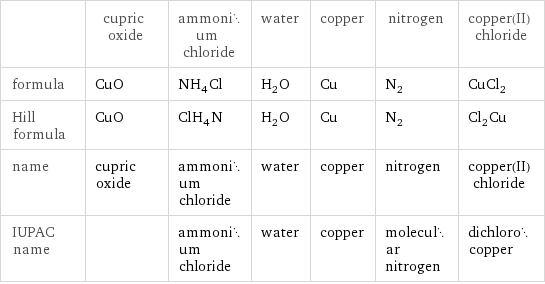
| cupric oxide | ammonium chloride | water | copper | nitrogen | copper(II) chloride formula | CuO | NH_4Cl | H_2O | Cu | N_2 | CuCl_2 Hill formula | CuO | ClH_4N | H_2O | Cu | N_2 | Cl_2Cu name | cupric oxide | ammonium chloride | water | copper | nitrogen | copper(II) chloride IUPAC name | | ammonium chloride | water | copper | molecular nitrogen | dichlorocopper
Substance properties
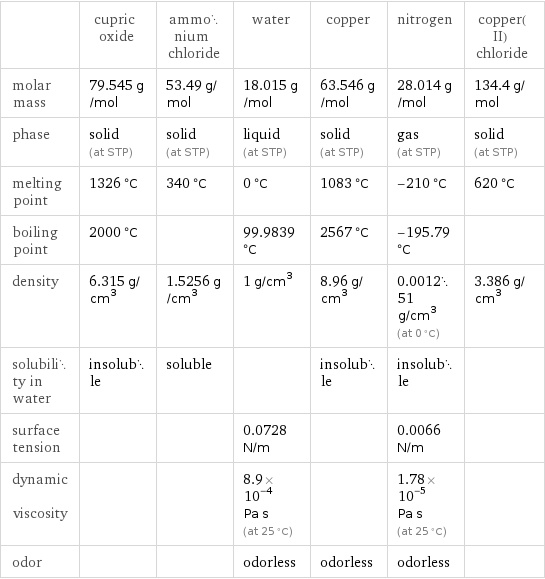
| cupric oxide | ammonium chloride | water | copper | nitrogen | copper(II) chloride molar mass | 79.545 g/mol | 53.49 g/mol | 18.015 g/mol | 63.546 g/mol | 28.014 g/mol | 134.4 g/mol phase | solid (at STP) | solid (at STP) | liquid (at STP) | solid (at STP) | gas (at STP) | solid (at STP) melting point | 1326 °C | 340 °C | 0 °C | 1083 °C | -210 °C | 620 °C boiling point | 2000 °C | | 99.9839 °C | 2567 °C | -195.79 °C | density | 6.315 g/cm^3 | 1.5256 g/cm^3 | 1 g/cm^3 | 8.96 g/cm^3 | 0.001251 g/cm^3 (at 0 °C) | 3.386 g/cm^3 solubility in water | insoluble | soluble | | insoluble | insoluble | surface tension | | | 0.0728 N/m | | 0.0066 N/m | dynamic viscosity | | | 8.9×10^-4 Pa s (at 25 °C) | | 1.78×10^-5 Pa s (at 25 °C) | odor | | | odorless | odorless | odorless |
Units
